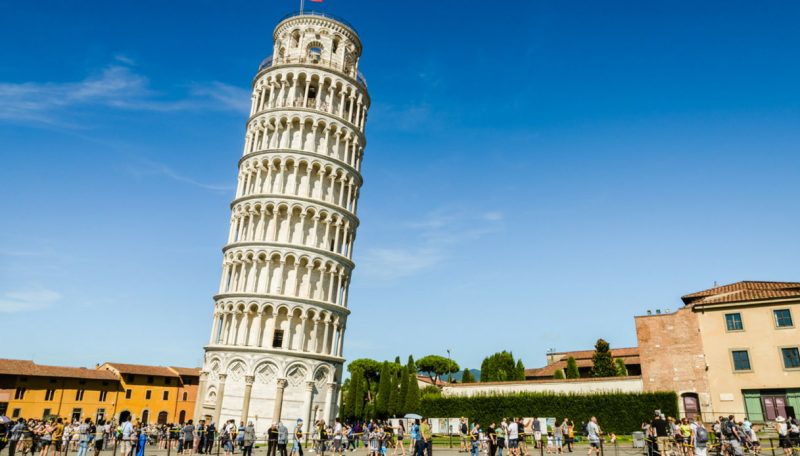The Leaning Tower of Pisa is famous for its slope which seems to defy every law of physics. Visitors suddenly appear in the midst of Square of Miracles. Its white beauty lights up the scene and is captured by millions of photo shoots every year.
The classic photo with the Tower of Pisa is well known: on the lawn in front of the Tower, intent on supporting it with both hands, or with the back. Not everyone knows, however, that over the years there have been many maintenance and renovation works on the Tower, aimed at saving it from subsidence or degradation of the marble surfaces. Let's take a look at the history and curiosities related to this Italian monument, also present at theItalia in Miniatura and symbol of Pisa, the city where he also studied nobel for math Alessio Figalli.

The story: a tower to attract the faithful
The Tower is none other than the bell tower of Cathedral of Santa Maria Assunta. The works for its construction began in 1173, but ended only in 1350. The tower is 56 meters high, has 8 floors and 7 bells still working. In addition, there are also two rooms: one at the base, called Fish room because of the subject depicted in a bas-relief, the other is the bell cell, on the seventh floor. The inclination is due to the clayey and sandy component of the soil of Pisa, and the first slope problems began during the construction of the third floor. After a long pause, the builders continued the construction of the next floors with a curvature in the opposite direction.
Some attempts gone… wrong!
The first straightening work of the Tower of Pisa began in the nineteenth century by Alessandro Gherardesca. An analysis of the ground had revealed a large amount of water in the subsoil of the Tower and it was thought to suck it with pumps. The result was not positive: the ground became more yielding and the slope of the Tower increased. In 1908 the Commission for the study of the conditions of the Tower of Pisa to safeguard the important historical and religious monument. In 1935 there was another unhappy one attempt to stabilize the Tower by Giovanni Girometti, with concrete castings which however further aggravated the inclination of the bell tower.
Over the years, the slope grew further, so much so that the collapse was feared. In 1990, lead counterweights were placed to balance the Tower, which it was now tilted 4,5 degrees.

The Opera della Primaziale Pisana and the works on the Tower
In 1999 a major tower stabilization project started, which ended in 2001 and led to a straightening of about 40 cm, bringing the bell tower back to an inclination of 4 degrees. Also, from 2001 to 2011 began the complete recovery of the Tower by restoring the beauty of the surfaces. These interventions were financed by the Ministry of Cultural Heritage and Activities and by theWork of the Pisan Primaziale. The latter is a secular-ecclesiastical institution born to direct the construction work of the monuments in Piazza del Duomo, and is therefore very ancient: the term began to be used in 1092 with Daiberto, archbishop of Pisa. Since 1987 the Opera has had legal personality and therefore has its own statute and its own organization chart with a President, which since 2000 is Pierfrancesco Pacini.

Some curiosities about the Tower of Pisa
Like any historical monument, the Leaning Tower of Pisa also has its peculiarities. For example, the 7 bells, now operated by an electronic system, they once rang according to the time of the liturgical day. For this they have gods names: Assunta (the largest), Crocifisso, San Ranieri, Dal Pozzo, Pasquereccia (the oldest, from 1262), Terza and Vespruccio.
The Tower is located in the Piazza del Duomo, also known as Piazza dei Miracoli, World Heritage Site since 1987.
Gabriele d'Annunzio in 1910 referred with the term "miracles" to the Cathedral, the Baptistery, the Campo Santo and the bell tower to enhance their beauty. From here "Square of Miracles”, A name popularized by the growing tourism during the post-war period. The Tower was also proposed as a possible candidate to become one of the New 7 wonders of the world, among which today we find the Colosseum.
Finally, the Tower is not the only leaning bell tower in Pisa. Due to the sandy and clayey soil, other bell towers have tilted: that of the Church of St. Nicholas of 2,5 degrees and that of Church of San Michele degli Scalzi of 5 degrees.





